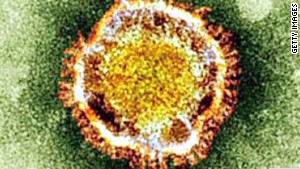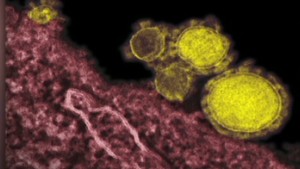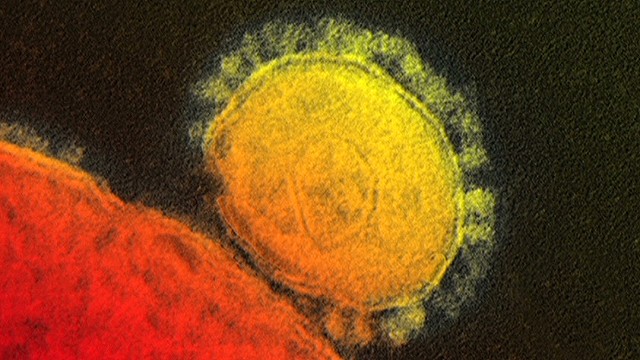updated 5:07 PM EDT, Sat May 3, 2014

First U.S. case of MERS confirmed
STORY HIGHLIGHTS
- The patient is a health care provider who traveled to Saudi Arabia
- MERS coronavirus was first reported in 2012 in the Middle East
- Saudi officials have noted a recent spike in cases
The
patient is a health-care provider who recently traveled to Saudi Arabia
to provide health care, said Dr. Anne Schuchat, assistant surgeon
general with the U.S. Public Health Service and director for the
National Center for Immunization and Respiratory Diseases.
The
person, an American male, traveled on April 24 from Riyadh to London,
then to Chicago, and took a bus to Indiana, officials said. He began
experiencing shortness of breath, coughing, and fever on April 27,
according to the Indiana State Department of Health.
The
patient was admitted to Community Hospital in Munster, Indiana, on
April 28, the same day he visited the emergency department there, the
health department said. He has been isolated and is in stable condition.
He is receiving oxygen support, but does not require a ventilator,
Schuchat said.
The
virus poses a "very low risk to the broader general public," Schuchat
said, as it has not been shown to spread easily from person to person.
The
CDC and the Indiana State Department of Health are conducting a joint
investigation into the case, according to a CDC statement. The CDC
confirmed Indiana test results on Friday.
"The
CDC, IDPH (Illinois Department of Public Health) and CDPH (Chicago
Department of Public Health) do not consider passengers on the flight or
bus to be close contacts of the patient and therefore are not at high
risk," said Dr. LaMar Hasbrouck, director of the IDPH.
Passengers
on the same plane and bus as the patient will be contacted by the CDC
as a precautionary measure, starting Saturday, the Illinois statement
said. If the CDC identifies ill individuals with possible MERS-CoV, it
will notify health officials in Chicago and Indiana.
"There
is no reason to suspect any current risk to travelers or employees at
O'Hare Airport at this time," said CDPH commissioner Bechara Choucair.
The coronavirus, known as MERS-CoV, was first reported in the Middle East -- specifically, the Arabian Peninsula -- in 2012.
Laboratory
testing has confirmed 262 cases of the coronavirus in 12 countries,
including the Indiana case, Schuchat said. Ninety-three people have
died.
So far, all MERS cases have been linked to six countries on or near the Arabian Peninsula, Schuchat said.
 Saudi officials see spike in MERS virus
Saudi officials see spike in MERS virus Health workers infected with coronavirus
Health workers infected with coronavirus  Gupta: MERS outbreak linked to camels
Gupta: MERS outbreak linked to camels Killer coronavirus in the Middle East
Killer coronavirus in the Middle East
.....
Centers for Disease Control and Prevention
Press Release
CDC announces first case of Middle East Respiratory Syndrome Coronavirus infection (MERS) in the United States
MERS case in traveler from Saudi Arabia hospitalized in Indiana
Middle
East Respiratory Syndrome Coronavirus (MERS-CoV) was confirmed today in
a traveler to the United States. This virus is relatively new to humans
and was first reported in Saudi Arabia in 2012.“We’ve anticipated MERS reaching the US, and we’ve prepared for and are taking swift action,” said CDC Director Tom Frieden, M.D., M.P.H. “We’re doing everything possible with hospital, local, and state health officials to find people who may have had contact with this person so they can be evaluated as appropriate. This case reminds us that we are all connected by the air we breathe, the food we eat, and the water we drink. We can break the chain of transmission in this case through focused efforts here and abroad.”
On April 24, the patient traveled by plane from Riyadh, Saudi Arabia to London, England then from London to Chicago, Illinois. The patient then took a bus from Chicago to Indiana. On the 27th, the patient began to experience respiratory symptoms, including shortness of breath, coughing, and fever. The patient went to an emergency department in an Indiana hospital on April 28th and was admitted on that same day. The patient is being well cared for and is isolated; the patient is currently in stable condition. Because of the patient’s symptoms and travel history, Indiana public health officials tested for MERS-CoV. The Indiana state public health laboratory and CDC confirmed MERS-CoV infection in the patient this afternoon.
“It is understandable that some may be concerned about this situation, but this first U.S. case of MERS-CoV infection represents a very low risk to the general public,” said Dr. Anne Schuchat, assistant surgeon general and director of CDC’s National Center for Immunizations and Respiratory Diseases. In some countries, the virus has spread from person to person through close contact, such as caring for or living with an infected person. However, there is currently no evidence of sustained spread of MERS-CoV in community settings.
CDC and Indiana health officials are not yet sure how the patient became infected with the virus. Exposure may have occurred in Saudi Arabia, where outbreaks of MERS-CoV infection are occurring. Officials also do not know exactly how many people have had close contact with the patient.
So far, including this U.S. importation, there have been 401 confirmed cases of MERS-CoV infection in 12 countries. To date, all reported cases have originated in six countries in the Arabian Peninsula. Most of these people developed severe acute respiratory illness, with fever, cough, and shortness of breath; 93 people died. Officials do not know where the virus came from or exactly how it spreads. There is no available vaccine or specific treatment recommended for the virus.
“In this interconnected world we live in, we expected MERS-CoV to make its way to the United States,” said Dr. Tom Frieden, Director, Centers for Disease Control and Prevention. “We have been preparing since 2012 for this possibility."
Federal, state, and local health officials are taking action to minimize the risk of spread of the virus. The Indiana hospital is using full precautions to avoid exposure within the hospital and among healthcare professionals and other people interacting with the patient, as recommended by CDC.
In July 2013, CDC posted checklists and resource lists for healthcare facilities and providers to assist with preparing to implement infection control precautions for MERS-CoV.
As part of the prevention and control measures, officials are reaching out to close contacts to provide guidance about monitoring their health.
While experts do not yet know exactly how this virus is spread, CDC advises Americans to help protect themselves from respiratory illnesses by washing hands often, avoiding close contact with people who are sick, avoid touching their eyes, nose and/or mouth with unwashed hands, and disinfecting frequently touched surfaces.
The largest reported outbreak to date occurred April through May 2013 in eastern Saudi Arabia and involved 23 confirmed cases in four healthcare facilities. At this time, CDC does not recommend anyone change their travel plans. The World Health Organization also has not issued Travel Health Warnings for any country related to MERS-CoV. Anyone who develops fever and cough or shortness of breath within 14 day after traveling from countries in or near the Arabian Peninsula should see their doctor and let them know where they travelled.
For more information about MERS Co-V, please visit:
Middle East Respiratory Syndrome:
http://www.cdc.gov/coronavirus/mers/index.html
About Coronavirus:
http://www.cdc.gov/coronavirus/about/index.html
Frequently Asked MERS Questions and Answers:
http://www.cdc.gov/coronavirus/mers/faq.html
Indiana Department of Health
http://www.state.in.us/isdh/
The CDC is also working closely with health officials from Indiana and Illinois to contain the virus that has no cure and can be deadly.
The man infected is a U.S. healthcare worker who was living and working in Saudi Arabia.
He came to Indiana for a conference and when he became ill he went to stay with family according to the Indiana State Department of Health.
The MERS patient flew from Saudi Arabia to London and then to O’Hare Airport before taking a bus to Indiana on April 24th.
After feeling ill, the man went to the emergency room at Community Hospital on April 28th, where doctors diagnosed him with MERS.
The CDC describes MERS as a “coronavirus”.
Symptoms include congestion and cough, fever above 100-degrees, shortness of breath, body aches and diarrhea.
The patient’s family and healthcare workers he had contact with will be monitored closely for signs of MERS.
The CDC is also contacting passengers that shared a plane or bus with the infected man.
“There
is no reason to suspect any current risk to travelers or employees at
O’Hare Airport at this time,” said CDPH commissioner Bechara Choucair.
The coronavirus, known as MERS-CoV, was first reported in the Middle East — specifically, the Arabian Peninsula — in 2012.
Read more at http://wgntv.com/2014/05/03/cdc-experts-arrive-in-nw-indiana-to-investigate-1st-u-s-case-of-mers/#w5etKS3qrU0sydcw.99
Investigators
from the Center for Disease Control arrived at the Community Hospital
in Munster, Indiana this morning to take over the treatment of the first
patient in the U.S. with Middle East Respiratory Syndrome or MERS.
The CDC is also working closely with health officials from Indiana and Illinois to contain the virus that has no cure and can be deadly.
The man infected is a U.S. healthcare worker who was living and working in Saudi Arabia.
He came to Indiana for a conference and when he became ill he went to stay with family according to the Indiana State Department of Health.
The MERS patient flew from Saudi Arabia to London and then to O’Hare Airport before taking a bus to Indiana on April 24th.
After feeling ill, the man went to the emergency room at Community Hospital on April 28th, where doctors diagnosed him with MERS.
The CDC describes MERS as a “coronavirus”.
Symptoms include congestion and cough, fever above 100-degrees, shortness of breath, body aches and diarrhea.
The patient’s family and healthcare workers he had contact with will be monitored closely for signs of MERS.
The CDC is also contacting passengers that shared a plane or bus with the infected man.
The CDC is also working closely with health officials from Indiana and Illinois to contain the virus that has no cure and can be deadly.
The man infected is a U.S. healthcare worker who was living and working in Saudi Arabia.
He came to Indiana for a conference and when he became ill he went to stay with family according to the Indiana State Department of Health.
The MERS patient flew from Saudi Arabia to London and then to O’Hare Airport before taking a bus to Indiana on April 24th.
After feeling ill, the man went to the emergency room at Community Hospital on April 28th, where doctors diagnosed him with MERS.
The CDC describes MERS as a “coronavirus”.
Symptoms include congestion and cough, fever above 100-degrees, shortness of breath, body aches and diarrhea.
The patient’s family and healthcare workers he had contact with will be monitored closely for signs of MERS.
The CDC is also contacting passengers that shared a plane or bus with the infected man.
“There
is no reason to suspect any current risk to travelers or employees at
O’Hare Airport at this time,” said CDPH commissioner Bechara Choucair.
The coronavirus, known as MERS-CoV, was first reported in the Middle East — specifically, the Arabian Peninsula — in 2012.
Read more at http://wgntv.com/2014/05/03/cdc-experts-arrive-in-nw-indiana-to-investigate-1st-u-s-case-of-mers/#w5etKS3qrU0sydcw.99
Investigators
from the Center for Disease Control arrived at the Community Hospital
in Munster, Indiana this morning to take over the treatment of the first
patient in the U.S. with Middle East Respiratory Syndrome or MERS.
The CDC is also working closely with health officials from Indiana and Illinois to contain the virus that has no cure and can be deadly.
The man infected is a U.S. healthcare worker who was living and working in Saudi Arabia.
He came to Indiana for a conference and when he became ill he went to stay with family according to the Indiana State Department of Health.
The MERS patient flew from Saudi Arabia to London and then to O’Hare Airport before taking a bus to Indiana on April 24th.
After feeling ill, the man went to the emergency room at Community Hospital on April 28th, where doctors diagnosed him with MERS.
The CDC describes MERS as a “coronavirus”.
Symptoms include congestion and cough, fever above 100-degrees, shortness of breath, body aches and diarrhea.
The patient’s family and healthcare workers he had contact with will be monitored closely for signs of MERS.
The CDC is also contacting passengers that shared a plane or bus with the infected man.
The CDC is also working closely with health officials from Indiana and Illinois to contain the virus that has no cure and can be deadly.
The man infected is a U.S. healthcare worker who was living and working in Saudi Arabia.
He came to Indiana for a conference and when he became ill he went to stay with family according to the Indiana State Department of Health.
The MERS patient flew from Saudi Arabia to London and then to O’Hare Airport before taking a bus to Indiana on April 24th.
After feeling ill, the man went to the emergency room at Community Hospital on April 28th, where doctors diagnosed him with MERS.
The CDC describes MERS as a “coronavirus”.
Symptoms include congestion and cough, fever above 100-degrees, shortness of breath, body aches and diarrhea.
The patient’s family and healthcare workers he had contact with will be monitored closely for signs of MERS.
The CDC is also contacting passengers that shared a plane or bus with the infected man.
“There
is no reason to suspect any current risk to travelers or employees at
O’Hare Airport at this time,” said CDPH commissioner Bechara Choucair.
The coronavirus, known as MERS-CoV, was first reported in the Middle East — specifically, the Arabian Peninsula — in 2012.
Read more at http://wgntv.com/2014/05/03/cdc-experts-arrive-in-nw-indiana-to-investigate-1st-u-s-case-of-mers/#w5etKS3qrU0sydcw.99
Investigators
from the Center for Disease Control arrived at the Community Hospital
in Munster, Indiana this morning to take over the treatment of the first
patient in the U.S. with Middle East Respiratory Syndrome or MERS.
The CDC is also working closely with health officials from Indiana and Illinois to contain the virus that has no cure and can be deadly.
The man infected is a U.S. healthcare worker who was living and working in Saudi Arabia.
He came to Indiana for a conference and when he became ill he went to stay with family according to the Indiana State Department of Health.
The MERS patient flew from Saudi Arabia to London and then to O’Hare Airport before taking a bus to Indiana on April 24th.
After feeling ill, the man went to the emergency room at Community Hospital on April 28th, where doctors diagnosed him with MERS.
The CDC describes MERS as a “coronavirus”.
Symptoms include congestion and cough, fever above 100-degrees, shortness of breath, body aches and diarrhea.
The patient’s family and healthcare workers he had contact with will be monitored closely for signs of MERS.
The CDC is also contacting passengers that shared a plane or bus with the infected man.
The CDC is also working closely with health officials from Indiana and Illinois to contain the virus that has no cure and can be deadly.
The man infected is a U.S. healthcare worker who was living and working in Saudi Arabia.
He came to Indiana for a conference and when he became ill he went to stay with family according to the Indiana State Department of Health.
The MERS patient flew from Saudi Arabia to London and then to O’Hare Airport before taking a bus to Indiana on April 24th.
After feeling ill, the man went to the emergency room at Community Hospital on April 28th, where doctors diagnosed him with MERS.
The CDC describes MERS as a “coronavirus”.
Symptoms include congestion and cough, fever above 100-degrees, shortness of breath, body aches and diarrhea.
The patient’s family and healthcare workers he had contact with will be monitored closely for signs of MERS.
The CDC is also contacting passengers that shared a plane or bus with the infected man.
“There
is no reason to suspect any current risk to travelers or employees at
O’Hare Airport at this time,” said CDPH commissioner Bechara Choucair.
The coronavirus, known as MERS-CoV, was first reported in the Middle East — specifically, the Arabian Peninsula — in 2012.
Read more at http://wgntv.com/2014/05/03/cdc-experts-arrive-in-nw-indiana-to-investigate-1st-u-s-case-of-mers/#w5etKS3qrU0sydcw.99The CDC is also working closely with health officials from Indiana and Illinois to contain the virus that has no cure and can be deadly.
The man infected is a U.S. healthcare worker who was living and working in Saudi Arabia.
He came to Indiana for a conference and when he became ill he went to stay with family according to the Indiana State Department of Health.
The MERS patient flew from Saudi Arabia to London and then to O’Hare Airport before taking a bus to Indiana on April 24th.
After feeling ill, the man went to the emergency room at Community Hospital on April 28th, where doctors diagnosed him with MERS.
The CDC describes MERS as a “coronavirus”.
Symptoms include congestion and cough, fever above 100-degrees, shortness of breath, body aches and diarrhea.
The patient’s family and healthcare workers he had contact with will be monitored closely for signs of MERS.
The CDC is also contacting passengers that shared a plane or bus with the infected man.
“There
is no reason to suspect any current risk to travelers or employees at
O’Hare Airport at this time,” said CDPH commissioner Bechara Choucair.
The coronavirus, known as MERS-CoV, was first reported in the Middle East — specifically, the Arabian Peninsula — in 2012.
Read more at http://wgntv.com/2014/05/03/cdc-experts-arrive-in-nw-indiana-to-investigate-1st-u-s-case-of-mers/#w5etKS3qrU0sydcw.99
.....

Amr Nabil/AP
Is Middle East Respiratory Syndrome (MERS) the Next SARS?
The first U.S. case of MERS landed in Indiana—smack-dab in the heartland. Is it time to panic?
The virus, MERS-CoV, belongs to a family of coronaviruses (CoV) and causes a series of symptoms. It was originally reported in Saudi Arabia in April 2012. The CDC reports 401 laboratory-confirmed cases of MERS, with 93 deaths. This virus’ high mortality rate—nearly 25 percent—and limited treatment options make it especially concerning to public health officials.
MERS conjures frightening memories of the 2003 SARS outbreak that originated in Hong Kong. There are similarities: Both are zoonotic viruses—meaning the virus acquired a mutation to jump from an animal host reservoir to a human host. The animal reservoir for SARS is bats, whereas the reservoir for MERS is primarily camels. Both are severe respiratory illnesses and the majority of symptoms revolve around progressive difficulty with breathing, oxygenation, and systemic infection.MERS patients tend to harbor preexisting health conditions and are much more likely to succumb to a MERS-CoV infection than a patient with SARS-CoV infection.
Read More Here
.....










No comments:
Post a Comment
Hello and thank you for visiting my blog. Please share your thoughts and leave a comment :)